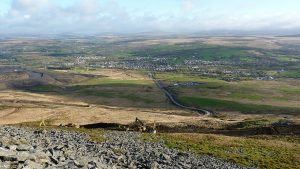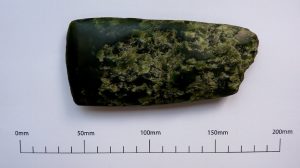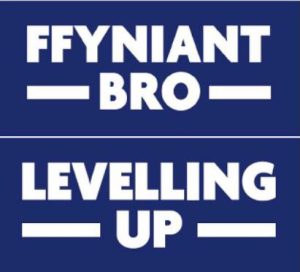A Different Way of Life: The Neolithic
The beginning of the ‘early Neolithic’ (c.4100-3000 BCE) saw individuals in society move from Mesolithic foraging to a more domesticated, sedentary lifestyle. This type of living is evident across Wales and in the archaeology of the Valleys. The climate generally would have been warmer and dryer than it is today. Evidence of Neolithic occupation has been found on high ground in the area. The finds suggest that people continued to hunt, as well as farm the land. In particular, archaeologists have found evidence of Neolithic life in Cwmbach and Aberaman where stone arrowheads and scrappers have been found during excavations.
With the introduction of farming, the population grew and social change occurred. Across Britain, new forms of burial were introduced alongside new tools for farming and working the land. Some of these objects became associated with status. During the Neolithic, the stone axe grew in importance and became increasingly valued beyond its value as a functional tool.
Archaeological evidence from across Britain suggests that in the early Neolithic, green jadeitite stone axes, already hundreds of years old, were arriving in Britain. Originating in the Alps, these axes are thought to have been passed down from generation to generation, linking together generations across hundreds of years. As time passed, people in Britain began to look for local sources of green stone, which they found in the igneous rocks of Britain and Ireland; these green stones continued to be transported across Britain, demonstrating their value and importance. Here in the Cynon Valley, we see evidence of this…

Mynydd Bwlfa
A Serpentine Handaxe from Mynydd Bwlfa
In 2014, a Neolithic stone axe-head was discovered ahead of the construction of Mynydd Bwlfa Wind Farm. It is thought to be between 6000 and 5100 years old. There are no known local sources of serpentine, and, combined with its appearance and internal weaknesses, this suggests that it originates from the shore edge, many miles away from the Cynon Valley. The internal weaknesses would have meant the axe was unlikely to have been used as one and instead remained valued for the stone it was made from and its ability to connect different generations. We will likely never know where it was originally deposited or why. It may have been simply lost, or there may be a more complex story behind it. For example, it is known from other sites in the UK that stone axes were placed as “offerings” and involved in religious activity (read more about the Serpentine handaxe here).

Serpentine Axe Head (side 1) (ACVMS:2019.114)
Today all we have left of the Neolithic in the Cynon Valley are the remnants of stone tools which were essential to everyday life. Some, such as the axe, would grow in meaning and become much more than just a tool. Just as this axe today links us to the ancestors of the Cynon Valley, it linked Neolithic people to those who had gone before them. As we move forward in time more changes arrived, with the use of metal spreading across Europe and it wouldn’t be long until it reached people in the Cynon Valley.
Further Reading
Miles D, 2016, The Tale of the Axe: How the Neolithic Revolution Transformed Britain, Thames and Hudson, London and New York
Pannett P, 2014, Lithic Artefact, in, Poucher P, 2014, Mynydd Bwllfa Wind Farm, Hirwaun, Rhondda Cynon Taf: Watching Brief, Archaeology Wales, Llanidloes
Whittle A, 2009, The Neolithic, c. 4000-2400 cal BC: A Changing World, in, Hunter J and Ralston I, 2009 (2nd ed), The Archaeology of Britain: An Introduction from the Earliest Times to the Twenty-First Century, Routledge, London and New York
To sign up for the latest museum news and newsletter follow the link here
To make a donation and ensure the museum’s future make a donation here
Follow us on Twitter, Facebook and Instagram




